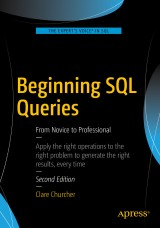Details

Beginning SQL Queries
From Novice to Professional2nd ed.
|
56,99 € |
|
| Verlag: | Apress |
| Format: | |
| Veröffentl.: | 06.07.2016 |
| ISBN/EAN: | 9781484219553 |
| Sprache: | englisch |
Dieses eBook enthält ein Wasserzeichen.
Beschreibungen
<p>Get started on mastering the one language binding the entire database industry. That language is SQL, and how it works is must-have knowledge for anyone involved with relational databases, and surprisingly also for anyone involved with NoSQL databases. SQL is universally used in querying and reporting on large data sets in order to generate knowledge to drive business decisions.</p><p>Good knowledge of SQL is crucial to anyone working with databases, because it is with SQL that you retrieve data, manipulate data, and generate business results. Every relational database supports SQL for its expressiveness in writing queries underlying reports and business intelligence dashboards. Knowing how to write good queries is the foundation for all work done in SQL, and it is a foundation that Clare Churcher's book, <i><b>Beginning SQL Queries</b></i>, 2nd Edition, lays well.</p><div><br></div><ul> </ul><div><b>What You Will Learn</b></div><div><div><ul><li>Write simple queries to extract datafrom a single table<br></li><li>Combine data from many tables into one business result using set operations<br></li><li>Translate natural language questions into database queries providing meaningful information to the business<br></li><li>Avoid errors associated with duplicated and null values<br></li><li>Summarize data with amazing ease using the newly-added feature of window functions<br></li><li>Tackle tricky queries with confidence that you are generating correct results<br></li><li>Investigate and understand the effects of indexes on the efficiency of queries<br></li></ul></div><div><b>Who This Book Is For</b><br></div></div><div><br></div><div><b>Beginning SQL Queries, 2nd Edition</b> is aimed at intelligent laypeople who need to extract information from a database, and at developers and other IT professionals who are new to SQL. The book is especially useful for business intelligence analysts who must ask more complex questions of their database than their GUI–based reportingsoftware supports. Such people might be business owners wanting to target specific customers, scientists and students needing to extract subsets of their research data, or end users wanting to make the best use of databases for their clubs and societies.<br></div><div><br></div>
1. Relational Database Overview.- 2. Simple Queries on One Table.- 3. A First Look at Joins.- 4. Nested Queries.- 5. Self Joins.- 6. Multiple Relationships Between Tables.- 7. Set Operations.- 8. Aggregate Operations.- 9. Window Function.- 10. Efficiency Considerations.- 11. Approaching A Query.- 12. Common Problems.- Chapter 13: Appendix 1: Sample Database.- Chapter 14: Appendix 2: Relational Notation.
<b>Clare Churcher</b> (B.Sc. (Hons), Ph.D.(physics)) has designed several databases for a variety of large and small projects. She is a currently a Senior Lecturer and Development Manager for Applied IT at Tai Poutini Polytechnic. She spent two years as a Business Analyst for a large international software development company, and prior to that nearly two decades as a senior faculty member of the Applied Computing Group at Lincoln University where her teaching included Analysis and Design, Database, and Programming papers. In 2006 she won a Lincoln University Excellence in Teaching Award. She has supervised over 70 undergraduate projects designing databases for small projects.
<p>Get started on mastering the one language binding the entire database industry. That language is SQL, and how it works is must-have knowledge for anyone involved with relational databases, and surprisingly also for anyone involved with NoSQL databases. SQL is universally used in querying and reporting on large data sets in order to generate knowledge to drive business decisions.</p><p>Good knowledge of SQL is crucial to anyone working with databases, because it is with SQL that you retrieve data, manipulate data, and generate business results. Every relational database supports SQL for its expressiveness in writing queries underlying reports and business intelligence dashboards. Knowing how to write good queries is the foundation for all work done in SQL, and it is a foundation that Clare Churcher's book, <b>Beginning SQL Queries</b>, 2nd Edition, lays well.</p><p><ul><li>Write simple queries to extract data from a single table<br></li><li>Combine data from many tables into one business result using set operations<br></li><li>Translate natural language questions into database queries providing meaningful information to the business<br></li><li>Avoid errors associated with duplicated and null values<br></li><li>Summarize data with amazing ease using the newly-added feature of window functions<br></li><li>Tackle tricky queries with confidence that you are generating correct results<br></li><li>Investigate and understand the effects of indexes on the efficiency of queries<br></li></ul></p><div><br></div>
Broad appeal – Developers, web designers, database administrators, even power users working with Microsoft Access need to know something of SQL Clarity – Author's previous book, Beginning Database Design, has established her as someone who writes with exceptional clarity about database topics Succinctness – Beginning Queries with SQL does not waste readers' time. It covers the ground in far fewer pages than do competing books
<p><b><i>Beginning SQL Queries, 2nd Edition</i></b> is a friendly and easily read guide to writing queries with the all-important — in the database world — SQL language. Anyone who does any work at all with databases needs to know something of SQL, and that increasingly today includes those using so-called NoSQL databases, because a strong trend in the industry is to make those databases accessible from SQL after all, at least for reporting purposes, and for analysis. <b><i>Beginning SQL Queries, 2nd Edition</i></b> is written by the author of <b><i>Beginning Database Design</i></b>, an author who is garnering great reviews on Amazon due to the clarity and succinctness of her writing.</p>
-
-
© 2024 media control GmbH
Alle Preise enthalten die gesetzliche Mehrwertsteuer. - AGB
- Impressum
- Datenschutzerklärung
- Kontakt
- FAQ
- Mein Konto
- Home
- Erweiterte Suche
- Widerrufsrecht
- Reader-Software
- Desktop-Ansicht
- Gutschein-Code einlösen


